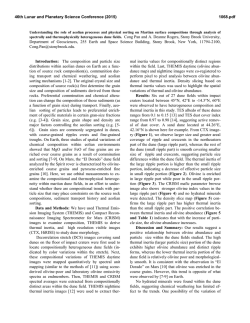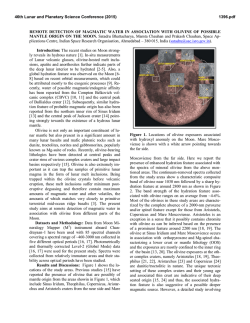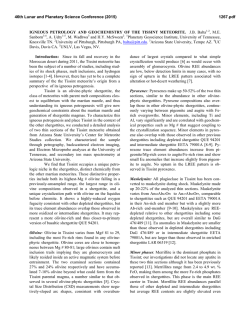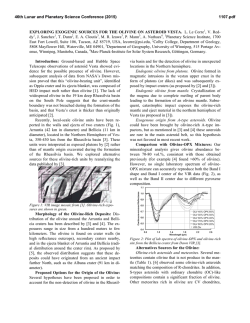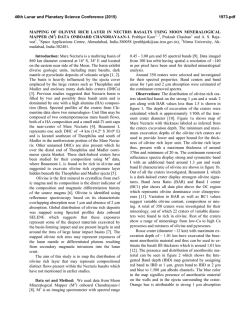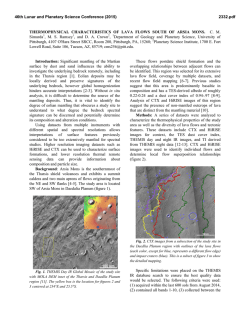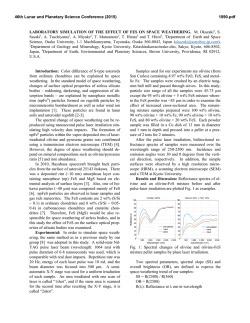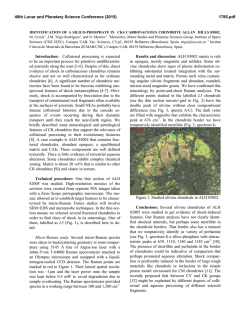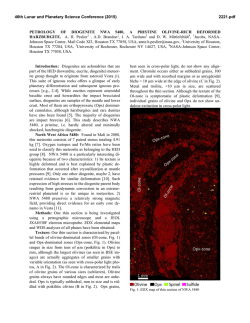
Evidence for Localized Variations in Olivine Weathering on Mars
46th Lunar and Planetary Science Conference (2015) 2481.pdf EVIDENCE FOR LOCALIZED VARIATIONS IN OLIVINE WEATHERING ON MARS. R.D. Hanna1 and V.E. Hamilton2, 1Jackson School of Geosciences, University of Texas, Austin, TX, 78712 ([email protected]), 2Southwest Research Institute, 1050 Walnut St., Suite 300, Boulder, CO 80302 Introduction: Previous studies have proposed that widespread olivine weathering aided by aqueous alteration leads to olivine-depleted sediment and soil on Mars [1,2]. If this is true, olivine content and thermal inertia (a proxy for particle size) should be positively correlated, and analysis of THEMIS imagery has suggested that this is indeed the case [2]. The goal of our work is to re-examine this proposed trend using larger, regional studies in addition to localized analyses and to quantify the possible correlation or non-correlation between thermal inertia and olivine content. Our work to date has suggested that on a global scale there is no evidence for such a trend [3], but that within regions where relatively olivinerich surfaces are found, there is support for a positive correlation [4]. For the final stage of our project we searched for and examined areas that might not exhibit this simple olivine-weathering trend: 1) low thermal inertia areas with significant olivine content and 2) high thermal inertia areas with relatively low olivine contents. Data and Methods: We used data from the Mars Global Surveyor Thermal Emission Spectrometer (TES) and 2001 Mars Odyssey Thermal Emission Imaging System (THEMIS) to determine thermal inertia and olivine content of the surface in all areas examined. For TES data, daytime bolometer-derived thermal inertia [5] was used along with the total normalized olivine content derived via spectral analysis from [6] for the same TES observation. In several areas we also selected a pair of overlapping daytime and nighttime THEMIS images for analysis. We limited the daytime THEMIS images to those with warm surfaces (average IR surface temperature >250 K) and selected nighttime images to maximize the overlap with the daytime image in the area of interest. THEMIS thermal inertia was derived from the nighttime images on a per-pixel basis using the observed surface temperature as a single-temperature input to the KRC thermal model [7]. Olivine abundance from THEMIS daytime images was determined using non-negative linear least squares (NNLS) fitting [8] of atmospherically corrected daytime THEMIS images [9]. The atmospheric correction will not completely eliminate contributions from water ice clouds [9], so an atmospheric water ice shape [10] was optionally included in the deconvolution end member set to account for variable water ice across the image. All other deconvolution end members (apart from the globally homogenous high albe- do surface (dust) dust shape [11]) were imagederived. To locate olivine-bearing areas with relatively low thermal inertia we produced a 2-degree-binned map from TES detections of normalized olivine contents of at least 25% and having a TES thermal inertia of 350 J·m-2·K-1·s-1/2 or less (SI units are assumed hereafter). To locate high thermal inertia deposits with low olivine content, we examined each of the 39 intercrater bedrock locations from [12] for the presence of olivine using TES-derived olivine maps [6] and 8-7-5 decorrelation stretched (DCS) THEMIS images in which olivine appears as a distinctive magenta color [13]. We also used olivine and pyroxene spectral parameter maps derived from the CRISM [14] and OMEGA [15] instruments to examine the mineralogy of several areas. Results: We examined eight olivine-bearing, low thermal inertia areas for this study. Two cases appear to be spurious detections of slightly elevated olivine contents, indicated by an along-track detection of olivine in one orbit with an absence of comparable olivine detections in other co-located orbits. In three cases limited olivine was present in the area but not consistently coincident with the lowest thermal inertia according to the TES. Two of the areas we examined contain olivine-bearing units with lower thermal inertias that are interpreted to result from partial dust cover. However, we found one area in Terra Cimmeria that contains olivine-bearing (~16%) crater ejecta with a lower thermal inertia (~272) than the underlying unit (~352) with lower olivine content (~7%). Out of the 39 intercrater bedrock locations from [12], only one location, in a Noctis Labyrinthus trough, exhibits no evidence of an olivine spectral signature (Figs 1-3). The small size and large depth (~5 km) of the trough relative the surrounding plateau precluded a reliable atmospheric correction of a THEMIS image for olivine content derivation, so 5 TES pixels covering the high inertia floor were used to derive the mineralogy of the unit. Our results confirm an earlier study with OMEGA [16] that the floor is generally basaltic with significant pyroxene and plagioclase with no strong evidence of olivine. Conclusions: We have found that relatively olivine-enriched regions do generally display a positive correlation between olivine content and thermal inertia, suggesting that olivine-rich rock is weathering to relatively olivine-poor sediment. However, we have also found localized examples in which this simple 46th Lunar and Planetary Science Conference (2015) olivine-weathering trend does not hold: 1) some relatively lower-thermal-inertia (< ~300) units retain a significant olivine composition (e.g., Terra Cimmeria, 16%) and 2) not all bedrock is olivine-enriched (e.g., Noctis Labyrinthus). This latter process might be particularly important in regards to the late Amazonian volcanism of the Tharsis region (which is mostly dust-covered) with which the olivine-poor Noctis Labyrinthus unit is associated [16]. Therefore, while evidence for olivine weathering may be common in dust-free regions of Mars there also exist localized examples where significant olivine weathering is not occurring. Thus, both geological and climactic factors are likely responsible for local variations in the role of aqueous alteration in the global production of olivine-poor sediment. References: [1] Bandfield, J.L et al. (2008) Geology, 36(7), 579-582 [2] Bandfield, J.L. et al. (2011), Icarus, 211, 157-171 [3] Hamilton, V.E. et al. (2010), LPSC XLI, abs #2239 [4] Hanna, R.D. and Hamilton, V.E. (2014) LPSC XLV, abs #2576 [5] Mellon, M. T. et al. (2000) Icarus, 148, 437-455 [6] Koeppen, W. C. and Hamilton, V. E. (2008) JGR, 113. [7] Kieffer, H.H. (2013) JGR, 118, 3, 451-470 [8] Rogers, A.D. and Aharonson, O. (2008) JGR, 113 doi:10.1029/ 2007JE002995 [9] Bandfield, J.L. et al. (2004) JGR, 109, doi:10.1029/2004JE002289 . [10] Bandfield, J.L. et al. (2000) JGR, 105, 9573-9588 [11] Bandfield, J.L. and Smith, M.D. (2003) Icarus, 161, 1, 47-65 [12] Edwards, C.S. et al. (2009) JGR, 114 E11001 [13] Hamilton, V.E., and Christensen, P.R. (2005) Geology, 33, 433-436. [14] Murchie, S. et al. (2007) JGR 112, E05S03. [15] Ody, A. et al. (2012) JGR 117, E00J14. [16] Mangold, N. et al (2010) EPSL, 294, 440-450. 2481.pdf Figure 1. Portion of CTX image G01_018678_1728_XN_07S099W over Noctis Labyrinthus trough. Figure 2. Thermal inertia derived from band 9 of THEMIS image I07450009 over Noctis Labyrinthus trough. Color bar represents thermal inertia from 80 (black-purple) to 600 (red) J·m-2·K -1·s-1/2 . Figure 3. Modeled mineral group abundances for 5 averaged TES surface spectra (OCK 3226) over highest thermal inertia area of Noctis Labyrinthus trough floor.
© Copyright 2025
